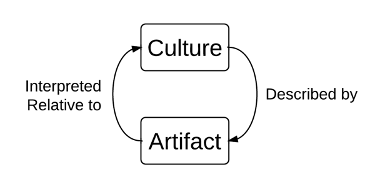Hermeneutic researchers fall into the hermeneutic cycle (see figure 1) in which an artifact is interpreted in light of the culture and then the culture is reinterpreted in light of the emerging understanding of the artifact. This cycle between the whole of the culture being reconstructed and the parts of the culture embodied in the artifacts continues until the research can justify his or her conclusions. Philosopher Shaun Gallagher (1992) articulates the connection between the hermeneutical approaches to understanding and solving problems and learning and the schools that are designed to support learners:
Things are not disjointed. Parts are parts of a whole. Learning does not consist of stumbling immediately upon an immediate, absolute, and satisfying knowledge of something. Learning is rather searching for understanding within a context” (195).

Figure 1. The hermeneutic cycle
When planners recognize the wicked nature of their work and they adopt a design process aligned with that proposed by Buchanan (1991) and with the hermeneutic researchers, they will necessarily adopt a Naturalistic stance towards the problems. Naturalistic epistemology generally holds that there are multiple realities and that it is not possible to separate what is known from the knower, and this is generally opposed to positivist epistemology which holds that there is a single reality and that it can be known through controlled and objective observation.
In their seminal book on Naturalistic inquiry, Yvonna Lincoln and Egon Guba (1985) argued that much scientific research is based on a reduction of the problem according to positivist principles, and that those assumptions are increasingly insufficient to describe many problems in the social sciences, including education. Whereas, positivist theory holds that a single reality exists and it can be understood through objective observation, Naturalistic researchers accept that role of the individual in creating and understanding knowledge and meaning. Whereas the positivist holds understanding of and control of causes can lead to predictable effects, the Naturalistic research holds that causes are largely unpredictable and uncontrollable. Also, the positivist holds that observers can make independent observations of situations, but the Naturalistic researcher is an active participant in the situation under study and the researcher is an active participant in data collection.
When adopting a Naturalistic stance towards curriculum and instruction, an educator will recognize that many factors influence decisions and progress and that many sources of data can be used to demonstrate learning. When documenting learning, Naturalistic educators include not only students’ performance on tests and similar ostensibly objective measures, but also students’ experiences and the meaning they make of those experiences. To the Naturalistic educator, there is no difference between a student who can’t solve a problem and one who solves it but for whom it has no meaning. The Naturalistic educator also follows the model of the Naturalistic researcher who undertakes emergent design. The researcher modifies research methods as the study progresses and the educator modifies the lesson as it progresses.
References
Gallagher, Shaun. 1992. Hermeneutics and Education. Albany, NY: State University of New York Press.
Lincoln, Yvonna, and Egon Guba, 1985. Naturalistic Inquiry. Thousand Oaks, CA: Sage Publications, Inc.